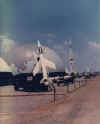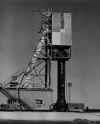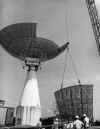1965
|
1965 Ordnance Corps ammunition training, including explosive ordnance disposal (EOD) training, was relocated to RSA. OGMS became the directing agency for nuclear weapons instruction, although training was conducted at other locations. Following the addition of these new missions the school was renamed the U.S. Army Missile and Munitions Center and School (OMMCS). |
|
1965 The PERSHING deployment schedule was met, with one CONUS ARSTRIKE battalion trained and equipped; three additional U.S. battalions deployed; and one battalion and one ground support unit awaiting fielding. Also, one Federal Republic of Germany (FRG) Air Force Wing, after being trained and equipped, returned home to West Germany. |
|
1965 The Office of the Chief of Research and Development (OCRD) asked the Aircraft Weaponization PM to procure eight smoke screen systems for operational use in Vietnam. These adapters fastened onto the XM3 rocket launcher and dispensed smoke grenades to lay a smoke screen for use in troop landings. |
|
1965 The first XM3 subsystems were deployed to the U.S. Army, Pacific and to Vietnam. |
|
1965 At DOD's direction, the MICOM Quality and Reliability Management Office played the primary role in developing and presenting the Zero Defects Program throughout the DOD/ Industry complex. The command also provided technical guidance to implement and sustain the program throughout the entire AMC structure. |
|
1965 MICOM absorbed personnel from other locations affected by DOD activities consolidation and base closures. About 120 Watertown Arsenal employees who had worked on containers were entitled to accompany their jobs to RSA when the container mission transferred. The command also planned to absorb about 225 spaces from seven eastern U.S. Army procurement districts that were phasing out under DOD Project 60, which involved the consolidation of supply contracts. In addition, MICOM hired about 35 employees from "stopper lists" created by the closing of bases or reducing of activities. |
|
1965 MICOM entered the AMC Talent Bank program early this year. The purpose of this program was to tabulate the skills available within AMC. All GS-5s and above, except clerical and secretarial personnel, registered as participants. |
|
1965 The MICOM value engineering (VE) effort was commonly called "eliminating goldplating." |
|
1965 In collaboration with the National Cancer Institute and the National Institutes of Health, MICOM conducted medical experiments using high energy laser irradiation of cancer in mice, rabbits, and monkeys. |
|
1965 Joint U.S./FRG studies on the Multiple Artillery Rocket System (MARS) began. MARS would provide a low-cost, rapid-fire weapon system capable of defeating both soft and hard targets by indirect fire at ranges intermediate between conventional cannon artillery and LANCE. The goal of the joint studies was to develop a common set of requirements and characteristics for the proposed system, with a possible joint MARS development program as the ultimate objective. |
|
27 January 65 MICOM forwarded the SIDEWINDER 1C/CHAPARRAL study and test results to AMC. The results indicated that such a system was feasible, but MICOM recommended that limited firing tests should be conducted to verify the predicted performance. |
|
February 65 The LACROSSE missile was classified obsolete. |
|
February 65 The AMSC Commander broke ground to begin construction on the Civilian Recreation Area located on the bank of the Tennessee River just off the southern end of Patton Road. |
|
March 65 ARPA asked MICOM to start a program of special intercontinental ballistic missile (ICBM) reentry tests called SPARTA. These tests were part of a group of programs pertaining to ballistic missile defense. Started in 1958, the program was known as Project Defender. Woomera, South Australia, was selected as the site for the tests because an operational radar system was available there to meet program objectives. A modified REDSTONE booster and two solid propellant upper stages comprised the vehicle. |
|
15 March 65 A new bus system was introduced at Redstone Arsenal. The vehicles were color coded so that passengers could pick the proper bus route. |
|
1 April 65 The Medium Antitank/Assault Weapon (MAW) Project Office was established at MICOM. It became fully operational by July. |

|
|
May 65 The USAF formally asked MICOM to participate in a short demonstration program to establish the practicality of laser guided bombs. Specifically, MICOM was tasked to provide laser illuminators and operators, technical assistance, and evaluation of the seeker proposals of the contractors selected by the Air Force to work on its "smart" bomb. Building on the technical base developed by the Army programs, the USAF and its contractors had expedited the "smart" bomb program. |
|
For more information on the development of laser-guided weapons, click here. |
|
12 May 65 The MICOM Commander revealed plans to keep the Pentadome display area open to visitors after Armed Forces Day, if public acceptance warranted the move. |
|
26 May 65 Troops of Battery C of the 2d Battalion, 4th Artillery fired a PERSHING missile from the Gilson Launch site near Green River, Utah, that had been programmed for a range of 410.4 nautical miles. This was the longest PERSHING flight to date. |
|
June 65 The MICOM-George C. Marshall Space Flight Center (MSFC) support agreement was revised for the fourth time to specify the medical services that MICOM would provide until the center had its own medical capability. |
|
18 June 65 The MICOM Commander formally opened the U.S. Army's Missile Display Area to the public on a permanent basis. |

|
|
July 65 Increased support to the logistics buildup in Southeast Asia (SEA) necessitated more personnel. MICOM requested 863 emergency spaces to handle the additional workload, but AMC only authorized some unvouchered spaces as an interim measure. |
|
14 July 65 To comply with Army regulations, the MICOM Commanding General assumed command of Redstone Arsenal from the AMSC Commander. |
|
2 August 65 The CHAPARRAL Commodity Office was established under the jurisdiction of the DCG, Air Defense Systems. |
|
16 August 65 SAM-D became project managed at MICOM. Its charter was issued on 10 November 65. |
|
3 September 65 Governor George C. Wallace signed legislation establishing the Alabama Space Science Exhibit Commission and providing for permanent displays of U.S. Army and NASA exhibits. |

|
|
15 September 65 MICOM held a kick-off ceremony at the Huntsville Municipal Stadium to dramatize its Zero Defects Program. |
|
17 September 65 MICOM discontinued commodity management functions pertaining to the REDSTONE and CORPORAL missiles. |
|
19 September 65 A reorganization and minor reduction-in-force (RIF) involving 545 employees took place to provide for more effective use of personnel in the headquarters and larger directorates as well as to combine certain functions of the MICOM Comptroller, Director of Programs, and the AMSC Finance and Accounting Office. |
|
6 October 65 AMC established a new Rocket Propulsion Technology and Management Center at MICOM to support Army-wide research and development of missile and rocket propulsion systems. |
|
November 65 Action began on developing technical requirements for ARPA's "Dancing Dolls" program to investigate a real time airborne reconaissance system. After the test program revealed technical problems greater than expected, work on the system for the Army's use was discontinued later in 1966. |
|
November 65 The MICOM Procurement and Production Directorate initiated the Replacement Opportunities as Developed Specialists (ROADS) program. ROADS would provide specially trained professional procurement personnel with the potential to fill key procurement positions in the future. |
|
10 November 65 The Special Assistant for Project Management formally announced the termination of the MAULER Project Office effective this date. The MICOM Research and Development Directorate assumed residual functions concerning technological aspects of the system. |
|
29 November 65 The CHAPARRAL Commodity Office, managed by AMC under the Interim Air Defense System (IADS) Project Office, was redesignated the CHAPARRAL Management Office. Subsequently, AMC delegated full line authority to this office for it to exercise integrated management of weapon system responsibilities. Within MICOM, this office was considered to be a project office. |
|
December 65 By the end of this month, all procurement districts had phased in Defense Contract Administration Services Regions (DCASRs), marking the end of Project 60. MICOM was established as a procuring activity with the implementation of Project 60. |
Excellence in Missilery:
Introduction,
1962,
1963,
1964,
1965,
1966,
1967,
1968,
1969,
1970,
1971,
1972,
1973,
1974,
1975,
1976,
1977,
1978,
1979





